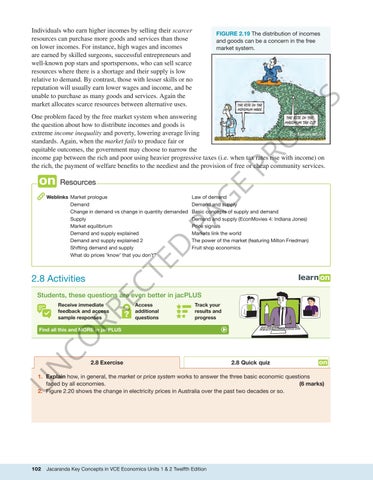“c02DecisionMakingInMarkets_PrintPDF” — 2022/5/25 — 13:13 — page 102 — #36
Individuals who earn higher incomes by selling their scarcer resources can purchase more goods and services than those on lower incomes. For instance, high wages and incomes are earned by skilled surgeons, successful entrepreneurs and well-known pop stars and sportspersons, who can sell scarce resources where there is a shortage and their supply is low relative to demand. By contrast, those with lesser skills or no reputation will usually earn lower wages and income, and be unable to purchase as many goods and services. Again the market allocates scarce resources between alternative uses.
FS
FIGURE 2.19 The distribution of incomes and goods can be a concern in the free market system.
PR
O
O
One problem faced by the free market system when answering the question about how to distribute incomes and goods is extreme income inequality and poverty, lowering average living standards. Again, when the market fails to produce fair or equitable outcomes, the government may choose to narrow the income gap between the rich and poor using heavier progressive taxes (i.e. when tax rates rise with income) on the rich, the payment of welfare benefits to the neediest and the provision of free or cheap community services.
E
Resources
Resourceseses
G
Law of demand Demand and supply Basic concepts of supply and demand Demand and supply (EconMovies 4: Indiana Jones) Price signals Markets link the world The power of the market (featuring Milton Friedman) Fruit shop economics
TE
D
PA
Weblinks Market prologue Demand Change in demand vs change in quantity demanded Supply Market equilibrium Demand and supply explained Demand and supply explained 2 Shifting demand and supply What do prices ‘know’ that you don’t?
CO RR EC
2.8 Activities
Students, these questions are even better in jacPLUS Receive immediate feedback and access sample responses
Access additional questions
Track your results and progress
N
Find all this and MORE in jacPLUS
2.8 Exercise
2.8 Quick quiz
U
1. Explain how, in general, the market or price system works to answer the three basic economic questions faced by all economies. (6 marks) 2. Figure 2.20 shows the change in electricity prices in Australia over the past two decades or so.
102
Jacaranda Key Concepts in VCE Economics Units 1 & 2 Twelfth Edition





















































